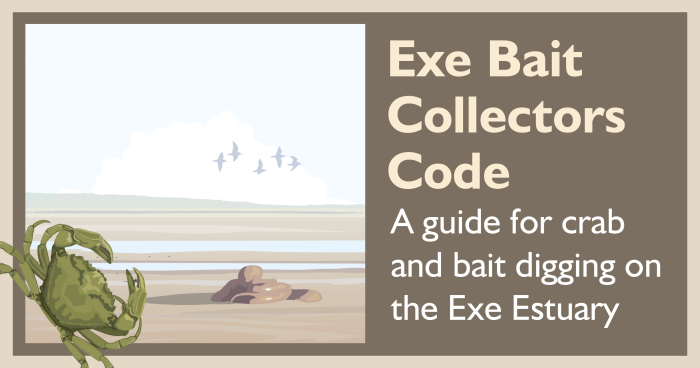
The Exe Estuary is a wonderful place to spend time outdoors, and those who work on the foreshore are perhaps the most aware of the beauty and the amount of wildlife that exists around our shore. There is a diverse mix of species that all belong to a complex ecosystem. This code has been drawn up following consultation with those that have an interest in the practice of collecting bait within the Exe Estuary. The reason for the Code is to:
- help reduce the risk of conflict between those who collect angling bait and other estuary users
- help crab tilers and bait diggers ‘farm’ the estuary in a way that respects nature, sustaining stocks, both now and in the future
The organisations responsible for regulating bait collection on the estuary will monitor this code. If is it not adhered to regulations will be introduced to control and manage these activities.
Crab Tiles The definition of ‘Crab Tiles’ for this Estuary code means any form of artificial habitat, structure or shelter to aid the collection of shore crab.
Safety
Remember that estuaries are dangerous places with fast moving tides, strong currents and soft mud. Check tide times for Exmouth Dock, and see the Exe Water Users and Exe Shore Codes for more information.
Watch out for wildlife
The mudflats, sandbanks and marshland of the estuary are of international importance as a Special Protection Area (SPA) for thousands of birds and the valuable habitats that support them and other wildlife. The estuary is also a Site of Special Scientific Interest (SSSI) and Ramsar Site. It is not an unlimited resource. To make sure the site can be enjoyed for future generations please:
- avoid Wildlife Refuges, unless you have permission to crab tile
- keep noise to a minimum
- wait for birds to disperse before walking out on mudflats and keep your distance to avoid disturbance
- do not park vehicles on the foreshore
In using nature’s resource responsibly you can help maintain the source of bait stocks and allow nature to thrive at the same time.
Crab collectors code
- Through voluntary agreement of existing crab collectors it has been agreed that no more tiles should be placed on the estuary
- No crab tiles are to be placed outside of the agreed area, due to D&SIFCA’s Byelaw 24
- Be aware that permission of the landowner should be given before accessing the foreshore or placing crab tiles
- make sure you are aware of D&SIFCA, local council and Harbour Authority Byelaws, by contacting the appropriate authority
- To avoid causing difficulty or damage to other estuary users, if tiles need to be moved:
- avoid placing crab tiles in awkward or dangerous positions (e.g. near slipways)
- place crab tiles at a low angle – crab tiles should be no more than 20cm in height above the mudflat
- avoid using or placing crab tiles within 5m of commercial oyster and mussel beds and leave a 10m wide access route to each bed
- Only take crabs from tiles that you own, unless you have permission from the owner
- Never use materials such as asbestos or sharp metal which could have a detrimental impact on the environment or people
- Only take crabs that are fit for use as bait and return immature, berried (egg carrying) and non-moulting crabs.
Bait diggers code
- Avoid entering the Wildlife Refuges where safe to do so
- Avoid waste, take only bait for planned trips
- Eelgrass is an important feeding ground for protected birds, do not dig near eelgrass beds
- Back-fill any holes that you dig to restore the estuary and make it safe for other users
- Avoid collecting rare or unusual bait, such as the rare bristle worm
- Give consideration to other users, avoid digging near slipways, moorings and commercial fisheries